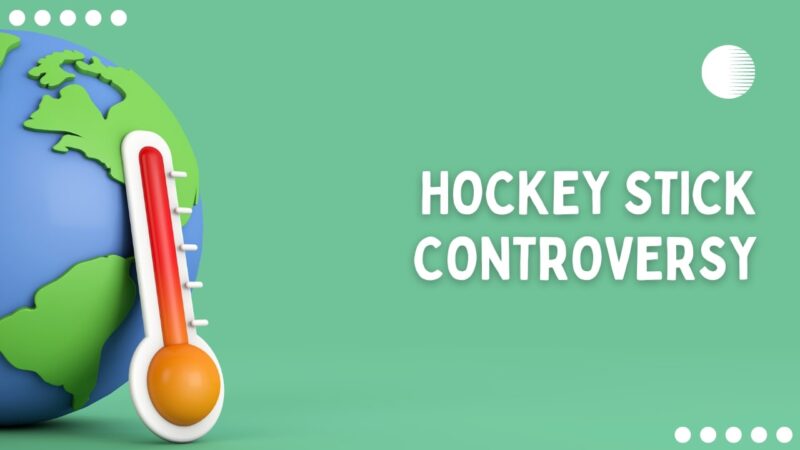The hockey stick graph, revered by some as a decisive piece of evidence, and dismissed by others as flawed science, presents an awe-inspiring visual representation of our planet’s temperature trajectory.
What truly fascinates me about this controversy is how it transcends its scientific roots and becomes entangled in the intricate web of politics, media, and public opinion. It’s a reminder that the pursuit of knowledge is not a solitary endeavor, but rather a complex interplay of various forces that shape our understanding of the world.
Within the pages of this article lies an expedition into the depths of the whole story, peeling back layers of historical context to expose its origins. It unfurls before you the impassioned arguments put forth by both champions and detractors, exploring the very essence of their positions.
Historical Background
In 1998, a research paper published in the journal ‘Nature’ by Michael Mann and his colleagues presented a reconstruction of past global temperatures dating back to the year 1400.
The reconstruction, visualized as a graph, showed a fairly flat line (the stick’s ‘shaft’) indicating relatively stable temperatures for most of the past 600 years, followed by a sharp uptick (the ‘blade’) in the 20th century. This depiction soon came to be known as the hockey stick graph.
Michael Mann, a climatologist at the University of Virginia, emerged as a central figure in the ensuing controversy. As lead author of the paper, Mann found himself in the crosshairs of critics who questioned his methodology and interpretations.
He and his colleagues defended their work and later extended the reconstruction back to the year 1000, reinforcing their conclusion that the recent warming was unprecedented in the past millennium.
The hockey stick graph generated considerable attention, both within and outside the scientific community. It was featured prominently in the Third Assessment Report of the Intergovernmental Panel on Climate Change (IPCC) in 2001.
For many, the graph provided a clear, visual depiction of the rapid warming experienced in the 20th century, elevating the urgency of climate change. But not everyone was convinced. Skeptics began to question the methodologies used in the reconstruction, giving rise to the hockey stick controversy.
Key Arguments of Supporters
The scientific consensus supporting the hockey stick graph is grounded on multiple lines of evidence. Most climatologists agree that Mann and his colleagues employed appropriate methodologies to construct their temperature timeline, using a variety of ‘proxy’ data sources such as tree rings, ice cores, and historical records to infer past climates.
Over the years, several independent studies have validated the findings of the hockey stick graph. In particular, the National Research Council (NRC) conducted a comprehensive review of Mann’s work and other temperature reconstructions.
Their 2006 report concluded that it was plausible to assert that the latter part of the 20th century was likely the warmest period in a millennium, corroborating the basic premises of the hockey stick graph.
Further, more recent studies using expanded databases and innovative statistical methods have largely confirmed the ‘hockey stick’ shape of temperature trends.
For example, a study by PAGES 2k Consortium in 2013, involving 78 scientists from 24 countries, presented a reconstruction that also depicted a sharp 20th-century warming following a long period of relatively stable climate.
Criticisms from Skeptics

Despite broad acceptance within the scientific community, the hockey stick graph has also been the subject of intense criticism.
Some skeptics have questioned the statistical techniques employed by Mann and his colleagues, suggesting that their method may artificially produce a hockey stick shape even from random noise.
Another point of contention has been the selection and handling of proxy data.
Critics like Stephen McIntyre and Ross McKitrick have argued that Mann’s reliance on certain tree ring data was flawed, as these proxies may not be accurate indicators of past temperatures. They contended that when these questionable data were removed, the shape disappeared.
Some critics also raised concerns about the ‘divergence problem,’ a phenomenon where tree-ring data and temperature measurements start to diverge in the late 20th century. Skeptics argue that if tree rings failed to capture the recent warming accurately, their reliability as temperature proxies in earlier periods could also be suspect.
Scientific Validity
In the face of criticism, it is vital to assess the scientific validity of the abovementioned graph.
The primary methodology employed by Mann and his team involves complex statistical techniques to reconstruct past climates using proxy data. While the method has been criticized, it has also been defended as a valid approach, especially in the absence of direct temperature measurements for the periods under study.
Statistical robustness is an important aspect of this debate. While certain criticisms have pointed out potential issues with Mann’s original work, subsequent studies have shown that the fundamental shape persists even when using different statistical methods or removing disputed proxies. This robustness lends credibility to the original findings.
Moreover, it’s worth noting that no single study or graph, including the hockey stick, is definitive in proving or disproving climate change. The graph is but one piece of a vast body of evidence demonstrating that the earth’s climate is warming, and that human activities are a significant driving factor.
Climategate Scandal
The controversy took a dramatic turn in 2009 with the Climategate scandal, when hackers released a trove of emails from the Climatic Research Unit (CRU) at the University of East Anglia. Among these emails were private correspondences between Mann and other climate scientists discussing their work and dealing with climate skeptics.
The release of these emails fueled allegations of data manipulation and suppression of dissenting views. Critics pointed to certain phrases in the emails, accusing the scientists of trying to ‘hide the decline’ in temperatures suggested by certain tree ring data, which seemingly contradicted the graph’s portrayal of recent warming.
The Climategate scandal had a profound impact on public perception of the hockey stick controversy. While many in the scientific community viewed the incident as a misrepresentation and out-of-context reading of the emails, for others, it served to amplify existing doubts about the graph and the integrity of climate science.
Expert Panel Investigations
Following the Climategate scandal, a series of investigations were undertaken by various scientific organizations to examine the allegations against Mann and others. These panels scrutinized the scientists’ methods, data, and conduct to assess if there had been any malpractice.
One such investigation was conducted by the Pennsylvania State University, where Mann was a faculty member.
The university’s inquiry exonerated Mann of the allegations, finding no evidence of suppression or falsification of data. Similarly, a review by the UK House of Commons Science and Technology Committee found no fault with the scientific practices at the CRU.
On a larger scale, a comprehensive review by the NRC found no evidence of scientific misconduct or dishonesty. It concluded that while there were certain areas where methodologies could have been more transparent or rigorously applied, the broad conclusions drawn by Mann and his team were plausible.
Policy Implications

The hockey stick controversy has had significant implications for climate change policies. On one hand, the graph’s stark depiction of unprecedented modern warming has been used to underscore the urgency of mitigating climate change. It has informed policy decisions and bolstered arguments for reducing greenhouse gas emissions.
On the other hand, the controversy surrounding the graph has been leveraged by climate skeptics to cast doubt on the severity of anthropogenic climate change, at times stalling policy actions. Some politicians have seized on the controversy to question the scientific consensus on climate change and to justify opposition to climate-related regulations.
Moreover, the controversy has served to highlight the intersection of science and policy. It underscores the importance of clear, transparent, and robust scientific communication in shaping policy decisions and the need for policymakers to accurately interpret and apply scientific findings.
Relevance to Climate Change Discourse
The controversy plays a significant role in the broader climate change debate.
It underscores the fact that while the scientific consensus is overwhelmingly in favor of human-induced climate change, there remain areas of uncertainty and ongoing debate. These areas, including past climate reconstructions, are often seized upon by skeptics to sow doubt about the entire field.
Importantly, the controversy has also impacted public trust in climate science. The criticisms leveled at the graph and the fallout from the Climategate scandal have contributed to public confusion about the consensus on climate change, and in some cases, fostered skepticism.
Yet, the controversy also offers an opportunity for improving scientific literacy. It highlights the nature of scientific research as a process of continual refinement, where ideas are tested, challenged, and revised in light of new evidence. This understanding is crucial in a time when scientific findings play such a vital role in addressing global challenges.
Media Coverage
You’ll have to ask the IPCC why they dumped the hockey stick graph … https://t.co/JiTu40mPlR pic.twitter.com/BiwfEbFPAS
— John Shewchuk (@_ClimateCraze) June 13, 2024
Media portrayal of the hockey stick controversy has been varied, with different outlets emphasizing different aspects of the story.
Some media coverage has focused on the scientific debates about statistical methodologies and proxy data, while others have amplified the voices of skeptics, sometimes giving them a disproportionate platform relative to their representation in the scientific community.
The Climategate scandal was particularly sensationalized in the media, with some outlets framing it as a scandal that undermined the credibility of climate science. Such framing can influence public perception, potentially eroding trust in scientific institutions and consensus.
The role of the media in shaping understanding of the controversy underscores the importance of responsible science journalism. Accurate, nuanced, and contextual reporting can aid public understanding of complex scientific debates and their societal implications.
Lessons Learned
The hockey stick controversy offers valuable lessons for both the scientific community and the public. It emphasizes the importance of rigorous, transparent methodologies in scientific research. Scientists must clearly communicate their methods and data, enabling others to replicate and scrutinize their work.
The controversy also underscores the importance of peer review and open scientific debate. Criticisms and challenges to research findings, such as those leveled at the hockey stick graph, are crucial for refining and improving scientific understanding. This process, while sometimes contentious, is fundamental to scientific progress.
Lastly, the controversy highlights the role of science in informing policy and public opinion. It underscores the necessity of scientific literacy among the public and policymakers alike, to understand, interpret, and apply scientific findings responsibly.
FAQs
Has the hockey stick controversy been settled definitively?
While the argument has been extensively debated, it remains a topic of ongoing scientific inquiry and discussion.
Have there been any significant updates or developments in the hockey stick controversy in recent years?
Recent years have seen ongoing scientific research and discussions related to the altercation, including refinements in methodologies and the incorporation of new data.
Are there regional variations in the hockey stick graph’s temperature reconstructions?
Yes, the graph’s temperature reconstructions can show regional variations in temperature patterns over the past millennium, reflecting different geographical influences.
Are there alternative temperature reconstructions that differ from the hockey stick graph?
Yes, there are reconstructions that depict different temperature patterns over the past millennium. These reconstructions use various data sources and statistical techniques, resulting in slight variations.
How can the public differentiate between valid scientific concerns and misinformation regarding the hockey stick controversy?
It is essential for the public to critically evaluate the scientific evidence presented by both sides of the controversy, consider the consensus among experts, and rely on reputable sources of information.
Conclusion
I believe the hockey stick controversy is a complex issue situated at the nexus of science, politics, media, and public opinion. It is a testament to the contentious nature of climate change discussions and the challenges of conducting and communicating scientific research in this highly politicized context.
Understanding the complexities of climate change and its controversies, such as the hockey stick debate, is made easier by engaging with comprehensive resources, like the film ‘Before the Flood’, which offers a deep dive into the realities of climate change.
While the controversy has sparked intense debate, it is important to remember that the broad consensus on anthropogenic climate change is not hinged on a single graph or study. The hockey stick graph is one among a multitude of evidence pointing towards the reality of a warming planet.
As we navigate the climate crisis, understanding and learning from controversies such as this are critical. They not only help refine our scientific knowledge but also shed light on the vital role of transparent, robust, and responsible science in shaping our collective future.
To be more informed about these types of controversies be sure to visit beforetheflood.com!








